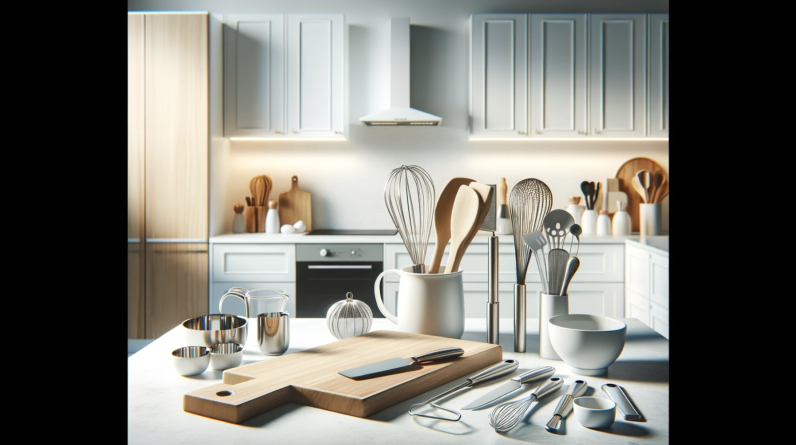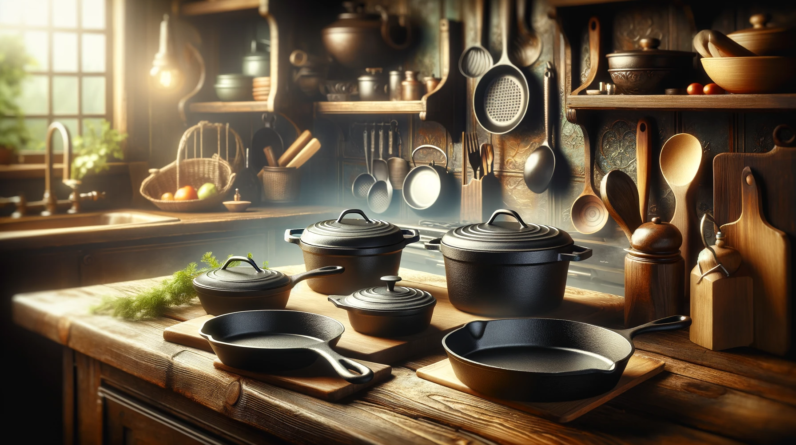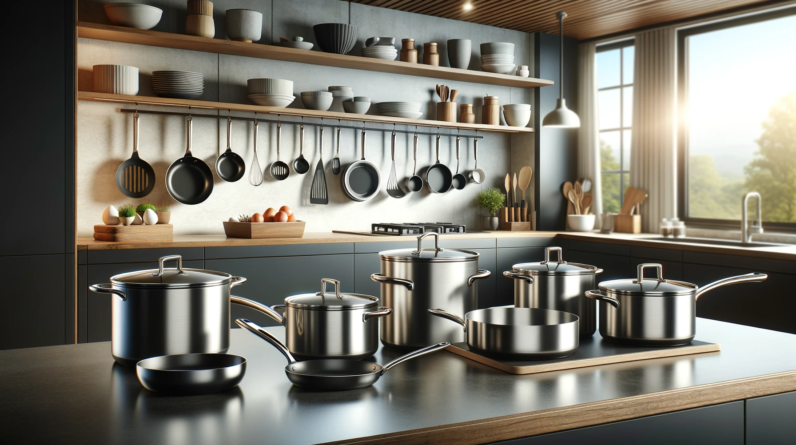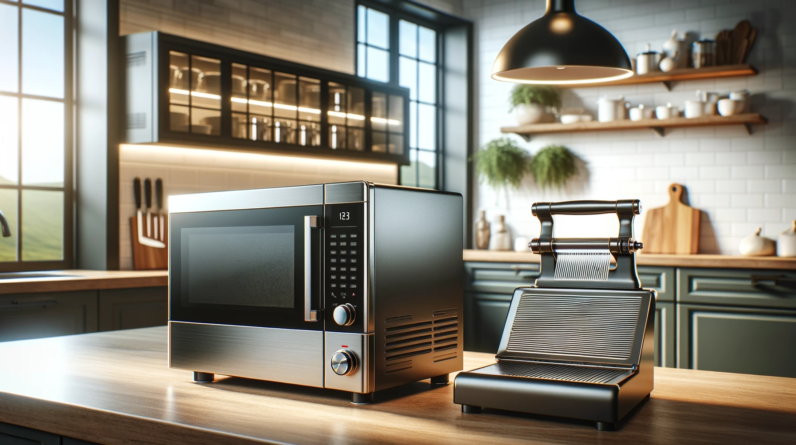
Disclaimer: This post may contain affiliate links. As an Amazon Associate, we earn from qualifying purchases.
So, you’ve decided to take your culinary skills to the next level and equip your kitchen with the best tools. But with the endless options available, how do you choose the right ones? The art of selecting kitchen tools can be as daunting as it is exciting.
From knives and pans to mixers and gadgets, there’s a world of choices out there. But fear not! In this article, we will guide you through the process of selecting the perfect kitchen tools that will not only make your cooking experience more enjoyable but also elevate your dishes to new heights.
How Do I Choose Kitchen Tools?
When it comes to choosing kitchen tools, there are several factors to consider. From the material and functionality to size and capacity, ergonomics, multifunctionality, budget, reviews, warranty, and storage, each aspect plays a crucial role in finding the perfect kitchen tools for your needs.
Let’s dive into each category and explore the factors you should consider when making your decision.
Material
Stainless Steel
Stainless steel kitchen tools are a popular choice due to their durability and resistance to rust and corrosion. They are known for their sleek and modern appearance, making them a great addition to any kitchen. Stainless steel tools also offer excellent heat resistance and are easy to clean, making them suitable for a wide range of cooking tasks.
Cast Iron
 have been used for centuries, and for good reason. They are incredibly durable and can last a lifetime when properly cared for. Cast iron retains heat well and distributes it evenly, which makes it a perfect choice for cooking tasks that require precise temperature control, such as searing or braising meat.
have been used for centuries, and for good reason. They are incredibly durable and can last a lifetime when properly cared for. Cast iron retains heat well and distributes it evenly, which makes it a perfect choice for cooking tasks that require precise temperature control, such as searing or braising meat.
While cast iron tools require a bit more maintenance, their exceptional performance and longevity make them worth the effort.
Aluminum
Aluminum is a lightweight material that offers excellent heat conductivity, allowing for fast and even cooking. It is also highly affordable, making it a popular choice for those on a budget. While aluminum tools are not as durable as stainless steel or cast iron, they are easy to clean and maintain.
However, it’s important to note that acidic ingredients can react with aluminum, so it’s best to avoid using them for cooking tasks that involve such ingredients.
Copper
Copper kitchen tools are known for their exceptional heat conductivity and quick response to changes in temperature. They provide precise cooking control and are often used by professional chefs. However, copper utensils require regular polishing and maintenance to prevent tarnishing. They also tend to be more expensive than other materials, making them a choice for those who value both performance and aesthetics.
Functionality
Preparation Tools
Preparation tools are essential for any cook. Knives, peelers, graters, and cutting boards are just a few examples of items that fall into this category. When choosing these tools, it’s important to consider the quality and durability of the materials, as well as their ease of use. Look for sharp blades that can be easily sharpened and comfortable handles that provide a secure grip.
Cooking Tools
Cooking tools include pots, pans, spatulas, tongs, and other utensils needed for cooking various dishes. When selecting cooking tools, consider their heat resistance, durability, and ease of use. Non-stick coatings and ergonomic handles are important features to look for, as they make the cooking process more enjoyable and efficient.
Serving Tools
Serving tools, such as serving spoons, ladles, and tongs, are used to transfer cooked food to plates or bowls. These tools should be sturdy, easy to handle, and have heat-resistant properties. Look for ergonomic designs that make serving comfortable and efficient.
Baking Tools
 Baking tools are essential for those who enjoy baking. Measuring cups, mixing bowls, whisks, and baking pans are just a few examples of items needed for successful baking. Look for baking tools that are made from durable materials, such as stainless steel or heat-resistant silicone.
Baking tools are essential for those who enjoy baking. Measuring cups, mixing bowls, whisks, and baking pans are just a few examples of items needed for successful baking. Look for baking tools that are made from durable materials, such as stainless steel or heat-resistant silicone.
Non-stick coatings and easy-to-read measurement markings are also important features to consider.
Quality
Durability
Durability is a key factor to consider when choosing kitchen tools. Look for tools made from high-quality materials, such as stainless steel or cast iron, that can withstand the test of time. Pay attention to the construction of the tools and ensure that they are solid and well-built.
Ease of use
Kitchen tools should be easy to use, regardless of your cooking expertise. Handles should be comfortable to grip, and the tools should be lightweight enough to handle with ease. Consider the design of the tools and look for features that enhance usability, such as non-slip handles or ergonomic shapes.
Maintenance
Maintenance is an important aspect to consider when choosing kitchen tools. Some materials, such as stainless steel and aluminum, are easy to clean and maintain, while others, like cast iron and copper, require more attention. Consider your willingness to invest time in cleaning and maintaining the tools before making your decision.
Brand Reputation
Brand reputation plays a significant role in ensuring the quality and reliability of kitchen tools. Research different brands and read customer reviews to gauge their reputation. Look for brands that are known for their commitment to providing high-quality products and excellent customer service.
Size and Capacity
Consider kitchen space
Before purchasing kitchen tools, it’s important to consider the available space in your kitchen. Measure your cabinets, drawers, and countertops to ensure that the tools you choose will fit comfortably. Look for space-saving options, such as stackable or nesting tools, to make the most of your kitchen storage.
Consider family size
The size of your family will determine the capacity of certain tools, such as pots and pans. If you regularly cook for a large family or frequently entertain guests, it’s important to choose tools that can accommodate larger quantities of food. On the other hand, if you primarily cook for one or two people, smaller-sized tools may be more suitable.
Consider typical cooking needs
Consider your typical cooking needs when choosing the size and capacity of kitchen tools. If you frequently cook dishes that require large pots or baking sheets, invest in tools that can handle those tasks. Conversely, if you tend to make smaller meals or have limited cooking needs, smaller tools may be more practical.
Ergonomics
Handle design
 Handle design is a crucial aspect of kitchen tools, as it determines the comfort and ease of use. Look for handles that are ergonomically designed to fit comfortably in your hand. Non-slip grips or textured surfaces can also enhance the stability and control you have while using the tools.
Handle design is a crucial aspect of kitchen tools, as it determines the comfort and ease of use. Look for handles that are ergonomically designed to fit comfortably in your hand. Non-slip grips or textured surfaces can also enhance the stability and control you have while using the tools.
Grip comfort
Grip comfort is directly related to handle design. Consider the material used for the handle and whether it provides a comfortable grip.
Soft-grip handles or handles with cushioning can significantly improve your cooking experience, especially when using tools for extended periods.
Weight balance
Weight balance is a factor that is often overlooked but can greatly impact the usability of kitchen tools. Look for tools that have a balanced weight distribution between the handle and the working end. This will ensure better control and reduce the strain on your wrist and arm while using the tools.
Multifunctionality
Versatile tools
Choosing kitchen tools that can perform multiple functions can save both money and valuable kitchen space. Look for tools that have multiple attachments or features, allowing them to be used for various tasks. For example, a blender with different attachments can serve as a food processor, juicer, or mixer.
Space-saving options
If you have limited kitchen storage space, consider opting for space-saving kitchen tools. Look for tools that can be stacked or nested together, allowing for efficient storage. Compact designs or tools with detachable handles can also help save space in your cabinets or drawers.
Combination sets
Combination sets are a great option for those looking to equip their kitchen with a variety of tools. These sets often include a range of cooking, serving, and preparation tools, all conveniently packaged together. Consider your specific needs and look for combination sets that include the tools you use most frequently.
Budget
Determining your budget
Before shopping for kitchen tools, it’s important to determine your budget. Consider how much you are willing to spend on each category of tools, such as preparation, cooking, serving, and baking. Set a realistic budget that aligns with your needs and preferences.
Comparing prices
Once you have determined your budget, it’s time to compare prices. Research different brands and models to get an idea of the average price range for the type of tools you are looking for. Keep in mind that higher-priced tools may offer better quality and durability in the long run, but there are also affordable options available that can meet your needs.
Considering long-term value
While budget is an important consideration, it’s also essential to consider the long-term value of the kitchen tools. Investing in high-quality tools that will last for years to come can save you money in the long run, as you won’t need to replace them as frequently. Consider the durability, reputation, and warranty of the tools to assess their long-term value.
Reviews and Recommendations
Reading customer reviews
One of the best ways to gauge the quality and performance of kitchen tools is by reading customer reviews. Take the time to read through reviews on reputable websites or online marketplaces to gain insights into the experiences of other users. Look for consistent positive reviews and pay attention to any negative feedback that may indicate potential issues.
Seeking expert opinions
Expert opinions can provide valuable insights into the quality and functionality of kitchen tools. Look for reviews or recommendations from reputable sources such as cooking magazines, culinary professionals, or cooking websites. These experts often have hands-on experience with a wide range of tools and can provide valuable guidance.
Asking for recommendations
If you have friends or family members who are passionate about cooking, don’t hesitate to ask for their recommendations. They can provide first-hand insights into the tools they love and use regularly. Their recommendations can help you narrow down your options and make an informed decision.
Warranty and Return Policy
Checking for warranty coverage
When investing in kitchen tools, it’s important to check for warranty coverage. A warranty provides protection against manufacturing defects or faulty materials. Look for tools that come with a substantial warranty period, as this indicates the manufacturer’s confidence in their product. Carefully read the terms and conditions of the warranty to understand what is covered and what is not.
Understanding return policies
In addition to warranty coverage, it’s crucial to understand the return policies of the retailer or manufacturer. Familiarize yourself with the return window, return conditions, and any associated fees. Having a clear understanding of the return policy ensures that you can return or exchange the tools if you are not satisfied with your purchase.
Storage and Maintenance
Consider storage options
 Consider the storage options available in your kitchen when choosing kitchen tools. Look for tools that can be easily stored in your cabinets or drawers, without taking up excessive space. Stackable or nesting tools are great space-saving options, as they can be stored together efficiently. Additionally, consider purchasing organizer racks or dividers to keep your tools organized and easily accessible.
Consider the storage options available in your kitchen when choosing kitchen tools. Look for tools that can be easily stored in your cabinets or drawers, without taking up excessive space. Stackable or nesting tools are great space-saving options, as they can be stored together efficiently. Additionally, consider purchasing organizer racks or dividers to keep your tools organized and easily accessible.
Check cleaning and maintenance requirements
Before purchasing kitchen tools, it’s important to consider their cleaning and maintenance requirements. Some tools can be cleaned in the dishwasher, while others may require handwashing. Check the manufacturer’s instructions to ensure that you can meet the maintenance needs of the tools.
Avoid purchasing tools that require excessive or complicated maintenance if it doesn’t align with your lifestyle.
Choosing the right kitchen tools requires careful consideration of various factors. From the material and functionality to size and capacity, ergonomics, multifunctionality, and budget, each aspect plays a vital role in finding the perfect tools for your needs.
Take the time to thoroughly research and consider your options, read reviews, and seek recommendations to ensure that you make an informed decision. By investing in high-quality tools that meet your specific needs, you can enhance your cooking experience and enjoy delicious meals for years to come.





